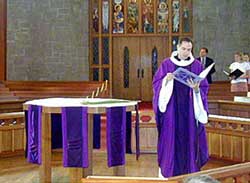
I have already reflected on giving up eggs during Lent (Northern Hemisphere early Spring) to allow eggs to hatch, rather than being eaten, and so replenish our supply of chickens.
Obviously Northern Hemisphere early Spring (Lent) is when the stored grain is running out. One would use the grain for sowing, and so have to cut down on what one used for eating in order to (as with eggs and future chickens) have food in the future. Scrapings in the grain store, not suitable for sowing,… make them into …pancakes! So one would have given up food or eaten less in Northern Hemisphere Lent because… there was none or little.
I have been told even the start of the military campaigning season was often delayed until the grain was collected – so that you could feed your army – at home or at your enemies expense.
I am not sure about the history of flowers in church, but a quick glance indicates that has been a practice for at least about a millennium (here and here). In early Northern Hemisphere Spring (Lent) there are few flowers. And the flowers that are there would often be blossoms. Picking blossoms for church, again, would cut down the future food supply, so not putting flowers in church in Lent allows an abundant fruit harvest.
In over half the planet none of this means anything. In the Southern Hemisphere at this time of Lent (early Autumn) food is fresh and plentiful, fruit is ripening, and so forth. We have not seriously begun the work of inculturation of the liturgy. In our global village I am not advocating that the Southern Hemisphere move the liturgical seasons. We need to find the essence of the liturgical season and embody that essence into our own context. As I say, we have a lot of work to do on that. This linked reflection of mine is one small step on that journey.
If you appreciated this post, there are different ways to keep in touch with the community around this website: like the facebook page, follow twitter, use the RSS feed,…



Perhaps salvation wasn’t intended for the creatures of the Southern Hemisphere. I am sure that I could twist some scripture from context to support that premise. 🙂
Yes, Br. David, I suspect you and I could find a scripture quote to support most things 😉 including that we, in the Southern Hemisphere, are either not needing salvation, or beyond being saved… Blessings.
There can certainly see something incongruous with Lent and Easter coming in the autumnal season, filled with plenty from the harvest and with winter coming. The inculturation and theological reflection on appropriate themes that could be done with this could be very interesting.
Your post lead me to a realization about our perceptions of this season. As I was reading the post something seemed a bit off to me. I couldn’t simply chalk it up to wondering if the practicalities of winter food stores and the coming spring would indeed lead to the lenten fast or if its a back fill by coincidence. I don’t know enough about agricultural practices in the medieval period or late antiquity in Europe to decide.
Further reflection lead me to realize the degree to which one’s own local climate can influence perceptions of these seasons, even in the northern hemisphere. Living deep in the interior of the North American continent on the northern high plains, spring is just beginning at Easter. While it starts to warm during Lent, and things may begin to grow and green late in the season, the median last freeze is in the first week of May. Many years most trees have yet to leaf out at Easter. It’s too early to think about actually planting anything during Lent, although many a gardener in Minnesota is drooling over their seed catalogs. One won’t see even early vegetables for at least a month after Easter, usually more, even if it’s late in the calendar. In this climate, Easter becomes associated not with renewed plenty or the return of full greenery, but with the beginnings of reawakening life after the long, dark, and frozen months.
Thanks, Mark. What you write is why I wrote “over half the planet”. Things differ again in Equatorial Northern Hemisphere. Blessings.
When Father Mickey was a missionary in Panama, he would write about it being summer there, when it was still winter in North America. For some reason the folks in Panama measure seasons with the southern hemisphere, even though they are quite some distance north of the equator
As always, Bosco, your Antipodean reflections are a much needed reminder to us northerners, who can take so much of the imagery of our liturgy for granted.
I find it helpful sometimes to think that it is not the northern hemisphere, as such, that has been privileged in the liturgical calendar, but rather Jerusalem and Bethlehem, which simply as a matter of fact both sit a hair south of 32° N. If our northern traditions (whose medieval expression is, as you note, very northern) were to “orient” themselves more towards that pole of cosmic salvation history, then the contrast with the southern hemisphere might not be so marked.
Then, of course, there are universally applicable Lenten disciplines to be learned from the early monastic customaries. Not just reduced food, but less frequent bathing and shaving. Has “Movember” made it to New Zealand? That is, for us, an autumnal observance 🙂
Perhaps we need not go so far as St Cuthbert, who would not remove his shoes from one Maundy foot-washing to the next… (Whose penance was that, really? his or the monk’s who had to wash his feet?)
Thanks, Jesse. And, yes, we have Movember here. In Spring. Blessings.